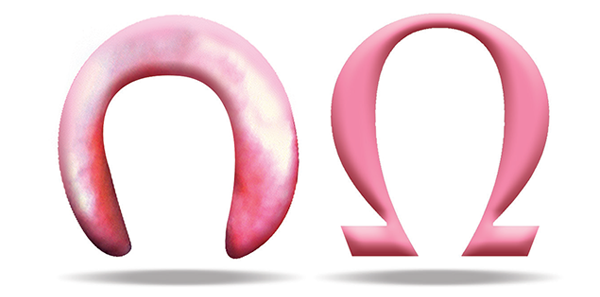
4 Using a straight blade direct laryngoscope. Find the epiglottis, then position the blade in the right side of the mouth, pivot the tip of the blade under the epiglottis, and advance slightly and then lift. Keep the proximal end of the blade in the extreme corner of the mouth (right paraglossal positioning). The small flange of the Miller design does not permit sweeping of the tongue. Moreover, the straight design does not allow pivoting back toward the center. Because of the shape of the dental arch, the straight blade (handle) can only pivot backwards if positioned all the way rightward (right on the right nostril).
Explore This Issue
ACEP Now: Vol 35 – No 06 – June 2016
(click for larger image)
Figure 1. Omega-shaped epiglottis visualized with GlideScope Titanium Macintosh #4 blade. The intubation is accomplished using a styletted tube (straight-to-cuff shape, 35 degrees) and “threading the needle” by carefully passing it through the omega-shaped epiglottis into the glottis. In bottom left image, the cuff is obscuring visualization of the target. In bottom right image, the tube can be seen passing over the posterior cartilages.

(click for larger image)
Figure 2. Omega-shaped epiglottis lifted directly by tip of Storz C-Mac blade. An advantage of the Storz C-Mac, GlideScope Titanium Mac, or McGrath Mac blades is that they can be used to lift the epiglottis directly if necessary (ie, using a curved blade like a straight blade). Size #4 Mac blades of these products work best and are recommended for all adult patients. The flange heights of all three of these products are the same in Mac #3 and Mac #4 sizes, and sometimes the extra blade length is necessary. Using a Mac #4 blade on all patients prevents having to switch to a larger size. Always start laryngoscopy holding the blade very lightly (two-finger grip with thumb) and follow down the tongue until the epiglottis is identified. For many patients, you will not need full insertion of the Mac #4, but having it readily available is very helpful.
Pages: 1 2 | Single Page






One Response to “Four Techniques for Handling the Omega-Shaped Epiglottis”
August 16, 2021
Marcelo S RamosThere are two epiglotiis variants that pose a challenge for intubation the omega shaped described in this issue and what I usually call “Elephant ear epiglottis”, a large floppy epiglottis that is exptremally soft and falls over the glottic openning when you perform DL/VL. For both I adopt the solution of using the blade as if it were a straight Miller blade.